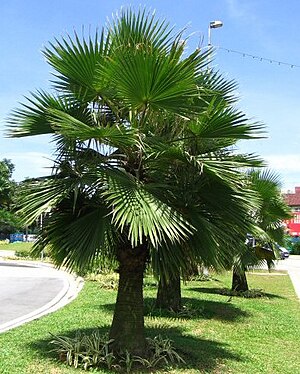Brahea
| Brahea | ||||||||||||
|---|---|---|---|---|---|---|---|---|---|---|---|---|

|
||||||||||||
| Systematics | ||||||||||||
|
||||||||||||
| Scientific name | ||||||||||||
| Brahea | ||||||||||||
| Mart. ex Endl. |
Brahea is an American genus of palm .
features
The representatives are mostly solitary, rarely clump-forming, moderately large, reinforced or unreinforced fan palms . They are hermaphroditic and bloom several times. The trunk is covered with the perennial leaf sheaths and only becomes bare with age.
The number of chromosomes is 2n = 36.
leaves
The leaves are folded induplicate, costapalmat for short, and remain on the plant after it dies (marzescence). The leaf sheath becomes fibrous, persistent and can tear at the base. The petiole is long or short, concave, flattened or furrowed on top, rounded on the underside. The stalk edges are unreinforced, or reinforced with small or large teeth, sometimes with flaky hair. The adaxial hastula is triangular to irregular, thin, membranous, fibrous and sometimes large. The abaxial hastula is either a narrow raised ridge or barely developed.
The leaf blade is approximately circular and regularly divided into simply folded, stiff or flexible segments up to the middle or above. The segments are deeply divided into two parts (bifid) at the end. Often there are filaments between the folds. The leaf surfaces are bare, waxy or covered with sloping, flaky hairs. The midribs protrude clearly.
Inflorescences
The inflorescences stand individually between the leaves (interfoliar). They are about the same length as or longer than the leaves, upright or curved and four-branched. The peduncle is slender and short to medium in length. The cover sheet is two-keeled, tightly fitting, tubular, glabrous and abaxially irregularly tearing. There are zero to several bracts on the peduncle. They are similar to the cover sheet, but are single-keeled and hairless or hairy. The inflorescence axis is significantly longer than the inflorescence stalk. The side axes of the first order are at larger distances and have no preceding pages. The following bracts are triangular, membranous and not very conspicuous. The flower-bearing axes (rachillae) are numerous, are crowded. All axes and the rachillae are densely hairy.
blossoms
The flowers are arranged in a hermaphrodite spiral. They stand alone or in coils of two to three flowers. Each stands in the armpit of a small bract. The buds are sometimes covered by hairs to the point of anthesis. The three sepals are free, imbricat and the edges are finely serrated. The three petals are fused at the base to form a tube that is as long as the calyx. On the adaxial side they are grooved shallow to deep. The six stamens are at the throat of the crown. The filaments have grown together to form a six-lobed ring. The lobes are triangular and abruptly narrow towards the tips. The anthers are broadly elliptical to elongated, dorsifix, posable and latrors. The gynoeceum consists of three carpels that are fused in the stylus area. The ovule is basal, upright and anatropic. The pollen is ellipsoidal and slightly to strongly asymmetrical. The germ opening is a distal sulcus.
Fruits and seeds
The fruit usually develops from just one carpel. It is spherical or ovoid and dark blue to black when ripe. The abortive carpels are basal, the scar remnants are apical. The exocarp is smooth, the mesocarp is fleshy, the endocarp is crusty.
The seed is basal or subbasal and is spherical to ellipsoidal. The endosperm is homogeneous and slightly to deeply indented by a smooth indentation of the seed coat.
distribution
The genus occurs in Baja California , on Guadalupe , in large parts of Mexico and in Guatemala . Their representatives grow over limestone in dry areas, mostly on slopes.
Systematics
The genus Brahea Mart. is placed within the family Arecaceae in the subfamily Coryphoideae , tribe Trachycarpeae . However, it cannot be assigned to any subtribe within the tribe.
The Royal Botanic Gardens, Kew's World Checklist of Selected Plant Families recognizes the following species:
- Brahea aculeata (Brandegee) HEMoore : The home is Mexico.
- Brahea armata S.Watson : The home is Baja California and Sonora in Mexico.
- Brahea brandegeei (Purpus) HEMoore : The home is Baja California and Sonora in Mexico.
- Brahea calcarea Liebm. : The distribution area extends from western Mexico to Guatemala.
- Brahea decumbens Rzed. : The home is Mexico.
- Brahea dulcis (Kunth) Mart. : The distribution area extends from Mexico to Honduras.
- Brahea edulis H. Wendl. ex S.Watson : The home is Guadalupe .
- Brahea moorei L.H.Bailey ex HEMoore : Home is northeastern Mexico.
- Brahea pimo Becc. : The home is southwest Mexico.
- Brahea salvadorensis H. Wendl. ex Becc. : The home is El Salvador , Honduras and Nicaragua.
- Brahea sarukhanii H.J.Quero : The home is Mexico.
Brahea was first described by Endlicher in 1837 , the type species is Brahea dulcis (Kunth) Mart. (= Pritchardia filifera Linden ex André ). The generic name honors the Danish astronomer Tycho Brahe (1546–1601).
Synonyms are Erythea S.Watson and Glaucotheca O.F. Cook .
use
The leaves are used for roofing and processed into fibers. The fruits of some species are edible. In dry areas they are used as ornamental plants.
supporting documents
- John Dransfield, Natalie W. Uhl, Conny B. Asmussen, William J. Baker, Madeline M. Harley, Carl E. Lewis: Genera Palmarum. The Evolution and Classification of Palms . Second edition, Royal Botanic Gardens, Kew 2008, ISBN 978-1-84246-182-2 , pp. 276-278.
Individual evidence
- ↑ Rafaël Govaerts (ed.): Brahea. In: World Checklist of Selected Plant Families (WCSP) - The Board of Trustees of the Royal Botanic Gardens, Kew . Retrieved April 26, 2012.

